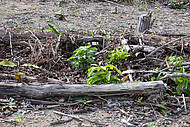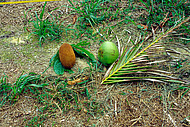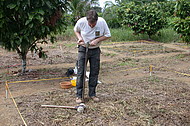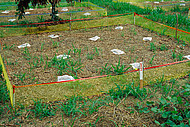Management of plant residues and its effects on decomposition and soil macrofauna in central Amazonian agroecosystems
SHIFT project ENV 52
Within the research program SHIFT (financial support by BMBF, Bonn and CNPq, Brasilia) a project executed by the State Museum of Natural History Karlsruhe and the EMBRAPA Amazônia Ocidental investigated the structure and function of soil macrofauna communities in Amazonian agroecosystems and the reaction of the fauna to experimental management measures like slash-and-burn, slash-and-mulch, slash-and-stockpile, intercropping of legumes for mulch production and the use of pesticides. In 8 different plantation types the soil fauna was sampled and the most important physical and chemical soil variables, which are supposed to contribute to soil fertility, were measured. These data formed the background for an evaluation of the effects of different mulch treatments on soil fauna and soil fertility. The crop species determines the soil fauna through its residues (litter quantity and quality) and by influencing habitat characteristics like microclimate or bulk density. Results show that soil fauna, and consequently soil fertility and the sustainability of the agroecosystem, can be managed by selecting and combining crop species, by alley cropping of shrubby legumes and mulching and by fire-free land preparation. Laboratory experiments and the study of soil profiles with special regard to biogenic structures have shown that specific soil fauna taxa have specific effects on soil structure, distribution of soil organic matter and nutrients and soil fertility. Ecotoxicological studies showed that tropical conditions influence tests and are relevant for a risk assessment of pesticides in the tropics. First tests under specific tropical conditions were successfully developed.Selected Publications
- Förster B., Garcia M., Höfer H., Morgan E., Römbke J. (2009):
- Tropical terrestrial model ecosystems for evaluation of soil fauna and leaf litter quality effects on litter consumption, soil microbial biomass and plant growth. PAB (Pesquisa Agropecuária Brasileira) 44: 1063-1071
- Höfer H., Ott R. (2009):
-
Estimating biomass of Neotropical spiders and other arachnids (Araneae, Opiliones, Pseudoscorpiones, Ricinulei) by mass-length regressions.
Journal of Arachnology 37: 160-169

- Brown GG., Römbke J., Höfer H., Verhaagh M., Sautter KD., Santana DLQ. (2006):
-
Biodiversity and function of soil animals in Brazilian agroforestry systems.
In: Sistemas Agroflorestais: Bases cientícias para o desenvolvimento sustentado, Campos dos Goytacazes, Brasilien : 217-242

- Martius C., Garcia MVB., Amelung W.;Höfer H., Verhaagh M. (2006):
- Soil fauna management in Amazonia: Making use of ecological services in agroecosystems. 18 World Congress of Soil Science: Symposium: Amazonian Dark Earth Soils (Terra Preta and Terra Preta Nova): A Tribute to Wim Sombroek, WCSS, Phildadelphia : 1
- Römbke J., Höfer H., Garcia MVB., Martius C. (2006):
-
Feeding activities of soil organisms at four different forest sites in Central Amazonia using the bait lamina method.
Journal of Tropical Ecology 22: 313-320

- Schmidt P., Lieberei R., Bauch J., Gasparotto L. (2005):
- Baumarten zum Aufbau nachhaltiger Mischkultursysteme in Zentralamazonien. BFH-Nachrichten 38443: 21-24
- Martius C., Höfer H., Garcia MVB., Römbke J., Förster B., Hanagarth W. (2004):
- Microclimate in agroforestry systems in central Amazonia: does canopy closure matter to soil organisms?. Agroforestry System 60: 291-304
- Martius C., Höfer H., Garcia MVB., Römbke J., Hanagarth W. (2004):
- Litter fall, litter stocks and decomposition rates in rain forest and agroforestry sites in central Amazonia. Nutrient Cycling in Agroecosystems 68: 137-154
- Ott R., Höfer H. (2003):
- Envia garciai, a new genus and species of mygalomorph spiders (Araneae, Microstigmatidae) from Brazilian Amazonia. Iheringia 93: 373-379
- Höfer H., Hanagarth W., Garcia MVB., Martius C., Franklin EN., Römbke J., Beck L. (2001):
- Structure and function of soil fauna communities in Amazonian anthropogenic and natural ecosystems. European Journal of Soil Biology 37: 229-235
- Römbke J., Höfer H., Martius C., Förster B., Franklin E.N., Garcia M.V.B., Beck L. (1999):
- Die Rolle der Bodenfauna beim Streuabbau in Primär - und Sekundärwäldern und einer Polykulturplantage in Amazonien (SHIFT Projekt ENV 52): Methodische Überlegungen. Ökotoxikologie - Ökosystemare Ansätze und Methoden (Oehlmann J., Markert B. Hrsg.) , Landsberg, Ecomed: 268-275
- Beck L., Gasparotto L., Förster B., Franklin EN., Garica MVB., Harada A., Höfer H., Luizao FJ., Luizao RCC., Martius C., De Morais JW., Römbke J. (1998):
- The role of soil fauna in litter decomposition in primary forests, secondary forests and a polyculture plantation in Amazonia: methodological considerations. Liebrei,R., Voss,K., Bianchi,H. (Hrsg.): Proceedings of the 3rd SHIFT-Workshop Manaus , Bonn, BMBF: 471-481
- Beck L., Höfer H., Martius C., Garica MVB., Franklin EN., Römbke J. (1998):
- Soil fauna and litter decomposition in primary and secondary forests and a polyculture system in Amazonia - study design and methodology. Lieberei,R., Voss,K., Bianchi,H. (Hrsg.): Proceedings of the 3rd SHIFT-Workshop Manaus , Bonn, BMBF: 463-469

Dr. Hubert Höfer, Dipl.-Biol.
Phone: +49 721 175 2826
E-Mail: hubert.hoefer[at]smnk.de

Dr. Florian Raub
Phone: +49 721 175 2820
E-Mail: florian.raub[at]smnk.de

Dr. Manfred Verhaagh, Dipl.-Biol.
Phone: +49 721 175-2835
E-Mail: manfred.verhaagh@smnk.de










